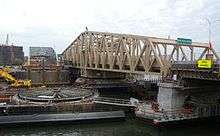Willis Avenue Bridge
Coordinates: 40°48′13″N 73°55′45″W / 40.80361°N 73.92917°W
| Willis Avenue Bridge | |
|---|---|
 New bridge | |
| Carries | Willis Avenue |
| Crosses | Harlem River |
| Locale | Manhattan and the Bronx in New York City |
| Maintained by | New York City Department of Transportation |
| Characteristics | |
| Design | Swing bridge |
| Total length | 3,212 feet (979 m) |
| Longest span | 304 feet (93 m) |
| History | |
| Opened | October 2, 2010 |
| Statistics | |
| Daily traffic | 62,062 (2012)[1] |
The Willis Avenue Bridge is a swing bridge that carries road traffic northbound (and bicycles and pedestrians both ways) over the Harlem River between the New York City boroughs of Manhattan and the Bronx, United States. It connects First Avenue in Manhattan with Willis Avenue in the Bronx. The New York City Department of Transportation is responsible for maintaining and operating the bridge.
The bridge is part of the course for the annual New York City Marathon. The runners, after crossing over from Manhattan to The Bronx via the bridge - which they have dubbed "the wall" because it marks the 20-mile point on the run - [2] then follow a short course through the borough and return to Manhattan for the race's final leg via the Madison Avenue Bridge.[3]
History
Old bridge

The bridge opened in 1901, at an original construction cost of $1,640,523.11 and a land cost of $803,988.37.[4] Major reinforcing work was done in 1916. However, in 1941, the bridge failed monthly inspection and therefore was converted to one-way operation northbound on August 5, 1941 on the same day the Third Avenue Bridge was similarly converted to one-way southbound.
Due to its poor condition, the bridge was replaced starting in 2007 and converted to pedestrian-only traffic for three years, and then was dismantled once a sidewalk was put in on the new bridge.
New bridge

In November 2005, New York City sought to replace the bridge. In an effort to preserve the structure, the city offered it for sale for $1, with free delivery within 15 miles.[4] Due to the difficult logistics of moving the structure, there were no bids as of March 2007.[5] Granite from the structure was given to a nearby park while the metal part was moved via tug to Jersey City on April 12, 2011, the steel melted and the concrete parts made into fill.[2][6]
The Department of Transportation opted to construct a new structure to the south of the existing bridge at a projected cost of $417 million. On March 8, 2007, when bidding for construction was opened, of the two bids offered, the lowest came in at $612 million. Iris Weinshall, the department commissioner, said that the city must go forward with the project because maintenance of the existing bridge is too expensive and the design of the ramps contribute to frequent accidents. This will be the most costly bridge construction project by the New York City Department of Transportation. Weinshall expected the project to last five years with construction beginning around the end of 2007.[5]

The replacement bridge was constructed at Port of Coeymans, 10 miles south of Albany. On July 13, 2010, the bridge was shipped down the Hudson on two barges that were welded together. The new bridge is 350 feet long, 65 feet high and 77 feet wide; it required three tugboats to propel it. The sight of the floating bridge caused a stir among onlookers all along the Hudson.[7] After a stay at Port Jersey in Jersey City it was towed up the East River to its destination in the morning on July 26.[8] Motor traffic was shifted to the new bridge on October 2, 2010, though the walkway of the old bridge continued to serve pedestrians and cyclists [9] for a few weeks.
Just upstream, the Third Avenue Bridge carries southbound traffic across the Harlem River from the Bronx to Manhattan as the other side of a one-way pair. That bridge was replaced in 2004.
In popular culture
"Willis Avenue Bridge" is the name of a song by David Berkeley from his 2009 album Strange Light.[10]
Public transportation
The Willis Avenue Bridge carries the Bx15 bus route operated by MTA New York City Transit. The route's average weekday ridership is 19,951.[11]
References
- ↑ "2012 New York City Bridge Traffic Volumes" (PDF). Retrieved 2014-09-23.
- 1 2 http://online.wsj.com/article/AP25e44815cecc4e1dbf9d8dd32b30c162.html Archived April 14, 2011, at the Wayback Machine.
- ↑ http://adventure.howstuffworks.com/outdoor-activities/running/events/nyc-marathon2.htm
- 1 2 Wilkinson, Alec (January 16, 2006). "Wanna Buy A Bridge?". The New Yorker. Retrieved 2006-06-21.
- 1 2 Neuman, William (March 31, 2007). "A Bridge No Longer So Humble, at $600 Million". The New York Times. Retrieved 2007-03-31.
- ↑ Roberts, Sam (April 25, 2011). "Willis Ave. Bridge Goes the Way of All Metal". The New York Times. Retrieved 2011-08-25.
- ↑ Kilgannon, Corey (July 31, 2010). "Heads Turn as a Bridge Floats By". The New York Times. Retrieved 2010-07-14.
- ↑ Hack, Charles (July 15, 2010). "New Willis Avenue Bridge arrives at Jersey City marine facility for finishing touches". The Jersey Journal. Retrieved 2010-10-01.
- ↑ NY1 News New bridge opens to traffic
- ↑ Hurt, Edd (July 1, 2009). ""Strange Light" review". American Songwriter. Retrieved 2009-08-28.
- ↑ "Average Weekday NYC Transit Bus Ridership". MTA New York City Transit. 2012. Retrieved 2012-07-04.
External links
| Wikimedia Commons has media related to Willis Avenue Bridge. |
- NYCRoads.com: Willis Avenue Bridge Historic Overview
- New York City Department of Transportation - Willis Avenue Bridge